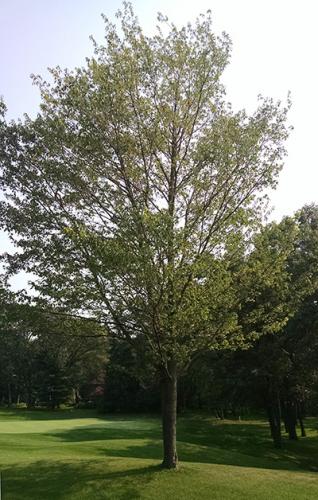Planting a tree successfully requires the correct planting depth
Even many years after planting, mistakes in planting depth can come back to haunt the tree.

Planting trees, regardless of their size, is an art combined with science. Scooping out a hole and booting the tree in is not the way to handle the most important part of this tree’s new life with you. Smart gardeners realize that the time spent planting the tree correctly has a much greater chance of leading to a long-term relationship between the tree and the smart gardener. Michigan State University Extension horticulture educators and Master Gardener hotline staff receive calls about apparently healthy trees dying suddenly, and questions about planting depth are included in the discussion.
The planting depth of the tree in its new location is very important. Trees planted too deep or too shallow shorten the tree’s life expectancy. Trees have roots that grow horizontally, and 80 percent of the tree’s roots are in the top 18-24 inches of soil. That’s a big, fat pancake just below the surface. Some trees have tap roots and others have some deep anchoring roots, but most are almost kissing the soil surface. Roots can grow far beyond the dripline, which is the length of the branches. When planted too shallow, or above grade, the roots that are supposed to grow horizontally have nowhere to go. They either stop at the edge of the planting hole or they grow into the mulch which does not hold moisture or nutrients well for the tree. If the tree is planted 6 inches above the surrounding terrain, that means one-third to one-fourth of its roots have nowhere to go. This is like tying up the front leg of your Kentucky Derby prospect and expecting the horse to place first when the starting gate opens.
One of the important functions of the roots closest to the surface is to take in air, use the carbon dioxide and make oxygen. This is called respiration. Since roots grow horizontally, respiration for the tree naturally happens. When the tree is planted too deep, or below grade, the roots still grow horizontally, not upwards. Most of the roots stay well below the place they should be and do not get enough air to perform normally.
 One simple check can indicate if an existing tree has been planted too deep. When viewing the lower trunk, it goes into the ground like a fence post goes into a hole. There is virtually no change in diameter where the trunk and soil meet. As trees age, many develop a trunk spread at ground level where the big supporting buttress roots flare away from the trunk. When in doubt, dig with your fingers close to the trunk. You are looking for large roots in the top 1-2 inches of soil. If all that is visible are small roots and no trunk flare, normal respiration cannot occur. The tree declines earlier and sometimes more dramatically that it should. There may be slowed growth or early loss of leaves in the fall. This also happens for trees planted above grade. The tree is not healthy and droughts and severe winters take more of a toll on the tree.
One simple check can indicate if an existing tree has been planted too deep. When viewing the lower trunk, it goes into the ground like a fence post goes into a hole. There is virtually no change in diameter where the trunk and soil meet. As trees age, many develop a trunk spread at ground level where the big supporting buttress roots flare away from the trunk. When in doubt, dig with your fingers close to the trunk. You are looking for large roots in the top 1-2 inches of soil. If all that is visible are small roots and no trunk flare, normal respiration cannot occur. The tree declines earlier and sometimes more dramatically that it should. There may be slowed growth or early loss of leaves in the fall. This also happens for trees planted above grade. The tree is not healthy and droughts and severe winters take more of a toll on the tree.
If the tree was planted above grade and you want to correct it, rake the mulch away from under the tree. Use the same garden soil as what is in the area and slope the soil gently away from the trunk in all directions. Soil goes on the sides, not the top. Rake gently to loosen the soil that is already there, then mulch your much larger planting mound.
If the soil is too wet and this is the reason the tree is perched on a soil pillow, the best choice is to find somewhere else to install the tree. Only a few trees can grow in wet soils and it may not be the one you chose.



 Print
Print Email
Email



